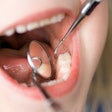
Water fluoridation above a certain level is linked to 30% higher than expected rates of hypothyroidism in England, according to a new study by U.K. researchers in the Journal of Epidemiology & Community Health.
They reported their findings from a large observational study of general practice physicians and fluoride levels in drinking water in the West Midlands and Greater Manchester areas.
"From a public health perspective, this raises questions about the safety of community fluoridation, and consideration should be given to reducing all sources of fluoride in the environment," the study authors wrote (J Epidemiol Community Health, February 24, 2015).
Community water fluoridation has been an accepted public dental health intervention since its introduction in the U.S. in the 1950s. In England, about 10% (6 million) of the population live in areas with a naturally or artificially fluoridated water supply of 1 mg fluoride per liter (mg/L) of drinking water, according to the study authors.
 Stephen Peckham, University of Kent Centre for Health Service Studies, Canterbury, U.K.
Stephen Peckham, University of Kent Centre for Health Service Studies, Canterbury, U.K.
"We found a significantly higher prevalence of hypothyroidism in areas with high fluoride levels (> 0.7 mg/L) compared with those with fluoride levels of 0.7 mg/L and below," wrote lead author Stephen Peckham, the director and a professor of health policy at the University of Kent Centre for Health Service Studies in Canterbury, U.K., and colleagues. The study did note that Peckham was involved in a campaign in Southampton, U.K., to prevent the fluoridation of drinking water supplies.
The researchers pointed out that the cross-sectional study is observational, so no definitive conclusions can be drawn about cause and effect, and they emphasized that they were not able to take account of other sources of fluoride found in dental products and food and drink.
But they point out that their findings echo those of previous research, and that while they were only able to look at diagnosed hypothyroidism, there might also be other cases of impaired thyroid function that have not yet been diagnosed and treated.
"Consideration needs to be given to reducing fluoride exposure, and public dental health interventions should stop [those] reliant on ingested fluoride and switch to topical fluoride-based and nonfluoride-based interventions," the researchers concluded.
Long-term effects
The U.S. Centers for Disease Control and Prevention (CDC) considers water fluoridation one of the greatest public health achievements in the 20th century. Yet controversy continues regarding the long-term health effects -- and potential risks -- of fluoride consumption.
“From a public health perspective, this raises questions about the safety of community fluoridation, and consideration should be given to reducing all sources of fluoride in the environment.”
Years of research by myriad public health agencies -- including the U.S. Food and Drug Administration, CDC, ADA, World Health Organization, and National Cancer Institute -- and nonpartisan groups such as the Pew Research Center have demonstrated that fluoridation is a safe and effective way to prevent caries, especially among children and underserved populations who have limited access to dental care.
All water contains some fluoride, the study authors noted, but fluoride levels of less than 0.3 mg/L are considered to confer no benefit to dental health, according to a 2012 U.K. report on community water fluoridation.
In the 1950s, fluoride was used pharmacologically to reduce the activity of the thyroid in people with hyperthyroidism. However, hypothyroidism and undetected subclinical hypothyroidism are associated with a number of health problems, studies show.
Between 4% and 5% of the U.S. population may be affected by a dysfunctional thyroid, making it among the most prevalent of endocrine diseases, according to a U.S. National Research Council study. In 2007/2008, the prevalence of hypothyroidism in the U.K. was 2.8%, which increased to 3.2% by 2012/2013, according to the study authors.
Varying fluoride levels
Current English policy for supplementing fluoride suggests a range of 0.7 mg/L and 1.2 mg/L should be targeted.
However, in Canada and southern Ireland the concentration is normally 0.7 mg/L with an upper limit of 1.2 parts per million (ppm), the study authors noted. In 2011, U.S. health officials proposed concentrations of 0.7 mg/L. The CDC's current recommended level for community water fluoridation is a range of 0.7 mg/L to 1.2 mg/L.
For this study, the researchers looked at the 2012 levels of fluoride in the drinking water supply, using data provided by the British Drinking Water Inspectorate for individual postal codes. They also looked at the national prevalence of hypothyroidism diagnosed by general practice doctors in England in 2012 to 2013 and recorded in the national health surveys. Complete data were provided for 7,935 general practices out of a total of 8,020.
The researchers also carried out a secondary analysis, comparing two cosmopolitan areas, one of which (West Midlands) was supplied with fluoridated drinking water and the other (Greater Manchester) was not.
Results
After taking account of influential factors, such as female sex and older age, both of which are linked to increased risk of hypothyroidism, the researchers found an association between rates of the condition and levels of fluoride in the drinking water.
In areas with fluoride levels above 0.7 mg/L, they found higher than expected rates of hypothyroidism than in areas with fluoridation below this level.
High rates of hypothyroidism were at least 30% more likely in practices located in areas with fluoride levels in excess of 0.3 mg/L. And practices in the fluoridated West Midlands were nearly twice as likely to report high rates of hypothyroidism as those in nonfluoridated Greater Manchester, the researchers found.
The study model predicts that the odds of a medical practice recording high rates of hypothyroidism is 1.4 times higher in areas with maximum fluoride levels of more than 0.3 mg/L and 0.7 mg/L or less and 1.6 times higher in areas with maximum fluoride in excess of 0.7 mg/L, than it is for practices in areas with maximum fluoride levels of 0.3 mg/L or less.
The researchers also pointed out that the analysis did not take into account sources of fluoride ingestion other than that in drinking water. Fluoride is found in many dental products and food and drink, they noted.
"Nevertheless, it is believed that drinking water is still the primary source of fluoride in England, particularly in areas with fluoride concentration of 1 mg/L and over," the study authors concluded.
In 2014, Canadian dentists and dental hygienists in Calgary, Alberta, reported seeing rampant caries in children's teeth following a decision to remove fluoride from the city's water supply three years ago.
A previous 2014 U.K. report by Public Health England, an agency of the Department of Health, found that children living in areas with water fluoridation have less tooth decay and fewer hospitalizations than those living in areas without water fluoridation. And another 2014 study in the British Dental Journal found that extending water fluoridation to U.K. areas with high levels of tooth decay could save millions and reduce the number of extractions in young people.



















